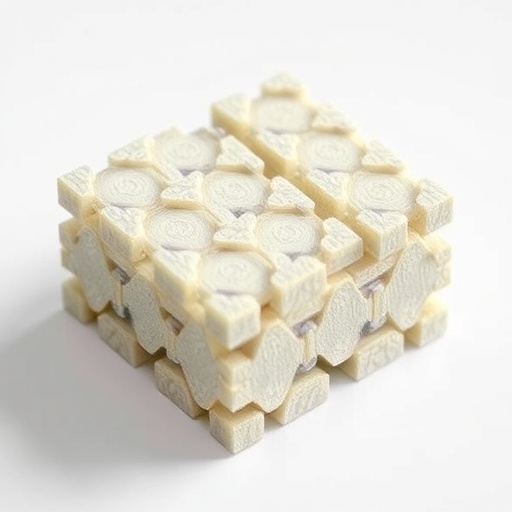In the rapidly evolving field of energy storage technology, researchers are continuously exploring innovative materials to enhance the performance of supercapacitors. A novel study undertaken by a team of scientists from leading institutions has put the spotlight on samarium-doped NiMoO₄-CoMoO₄ composites, which exhibit remarkable characteristics bolstered by the presence of oxygen vacancies. These materials are promising candidates for next-generation supercapacitors, potentially revolutionizing the efficiency and performance of energy storage solutions.
Supercapacitors have garnered significant attention due to their ability to deliver rapid bursts of energy, making them an excellent choice for applications ranging from electric vehicles to renewable energy systems. However, traditional supercapacitor materials often fall short in terms of energy density, which is crucial for advancing technology in this domain. The introduction of samarium-doping in NiMoO₄-CoMoO₄ composites opens new avenues for increasing the electrochemical performance of these devices.
The unique properties that samarium imparts to the NiMoO₄-CoMoO₄ composite include enhanced conductivity and increased surface area. These factors are instrumental in facilitating better charge transport and ion movement, leading to improved capacitance. The study emphasizes how tailoring the chemical composition through the incorporation of rare-earth elements like samarium can significantly influence the electrochemical behavior of the resulting material.
Another fascinating aspect of the research is the role of oxygen vacancies in the composite structure. Oxygen vacancies serve as additional sites for ion adsorption, which is crucial for the capacitor’s charge-storage mechanism. This phenomenon not only enhances the capacitance but also contributes to the overall stability of the electrochemical performance, offering a dual advantage in the quest for high-performance supercapacitors.
Through meticulous experimentation, the researchers have demonstrated that the samarium-doped NiMoO₄-CoMoO₄ composites showcase superior specific capacitance compared to their undoped counterparts. This key finding underscores the effectiveness of this novel doping strategy in enhancing the electrochemical properties of the materials. It exemplifies how even small modifications at the molecular level can yield significant improvements in performance metrics.
Moreover, the stability of these composites under various cycling conditions has been a pivotal area of focus. The study reports that the doped materials not only retain their capacitance over extended periods but also exhibit minimal degradation during charge-discharge cycles. Such stability is paramount for real-world applications where supercapacitors must withstand frequent cycling without loss of performance.
The researchers employed a variety of advanced characterization techniques to elucidate the structural and electrochemical properties of the composites. Techniques such as X-ray diffraction (XRD) and scanning electron microscopy (SEM) were instrumental in revealing the crystalline structure and morphology of the synthesized materials. These insights are vital for understanding how the arrangement of atoms influences the materials’ properties, which can be further exploited in future designs.
In addition to laboratory evaluations, the potential scalability of producing these samarium-doped composites is also discussed. The synthesis methods developed by the team are reportedly cost-effective and adaptable, making them suitable for large-scale production. This aspect is crucial, as it addresses one of the significant challenges in bringing advanced materials from research to market—economic feasibility.
As the demand for efficient energy storage solutions continues to soar, studies like this provide critical insights into developing materials that can meet these needs. The findings from this research not only push the boundaries of what is possible in supercapacitor technology but also provide a framework for further investigations into other potential doping agents and composite structures.
The implications of this research extend beyond just supercapacitors. The fundamental principles uncovered could be applied to a range of electrochemical devices, including batteries and fuel cells, thereby potentially transforming various sectors reliant on efficient energy storage. This cross-pollination of ideas showcases the interconnectedness of energy technologies and the need for collaborative approaches in addressing global energy challenges.
Moreover, the environmental impact of energy storage technologies cannot be overlooked. As researchers focus on energy efficiency, understanding the lifecycle of materials and their environmental footprint is becoming increasingly important. The exploration of rare-earth doping raises questions about sourcing, sustainability, and potential recycling pathways for advanced materials, making it essential for future studies to consider these factors.
With the publication of the study in a reputable journal, it is poised to attract considerable interest from both academia and industry. The potential applications of samarium-doped NiMoO₄-CoMoO₄ composites as high-performance supercapacitors could shape future energy storage solutions and inspire further research in the field. The excitement around this discovery may ignite new collaborations and initiatives to propel advancements in energy storage technologies.
The study represents a significant step forward in materials science, showcasing how innovative approaches can redefine the landscape of energy storage. As we move towards an increasingly electrified world, research like this will empower scientists and engineers to develop more efficient, reliable, and sustainable energy solutions for a myriad of applications.
In conclusion, the exploration of samarium-doped NiMoO₄-CoMoO₄ composites with oxygen vacancies highlights a promising direction for supercapacitor technology. With remarkable electrochemical performance, improved stability, and potential for scalability, these materials may well pave the way for the next generation of energy storage systems. Researchers in the field have set the stage for future investigations that may broaden our understanding and utilization of advanced composite materials in energy applications.
Subject of Research: Samarium-doped NiMoO₄-CoMoO₄ composites for supercapacitors.
Article Title: Samarium-doped NiMoO₄-CoMoO₄ composites with oxygen vacancies for high-performance supercapacitors.
Article References:
Ma, T., Li, A., Hao, J. et al. Samarium-doped NiMoO4-CoMoO4 composites with oxygen vacancies for high-performance supercapacitors.
Ionics (2025). https://doi.org/10.1007/s11581-025-06605-6
Image Credits: AI Generated
DOI: https://doi.org/10.1007/s11581-025-06605-6
Keywords: Samarium doping, NiMoO₄-CoMoO₄ composites, supercapacitors, energy storage, oxygen vacancies, electrochemical performance, stability, scalability.




